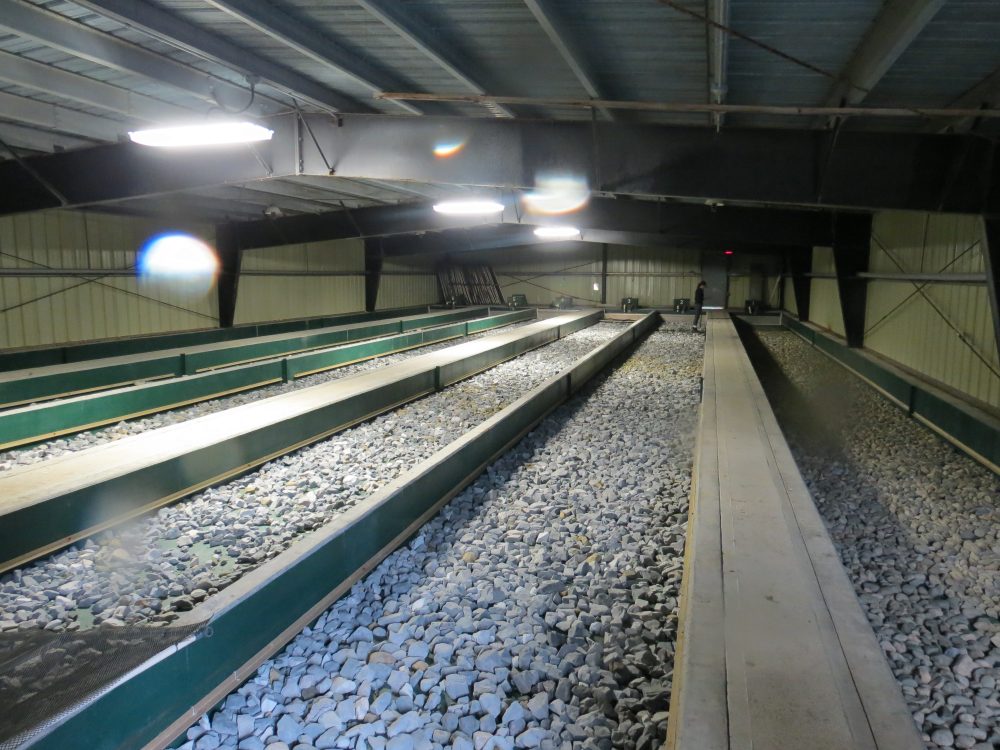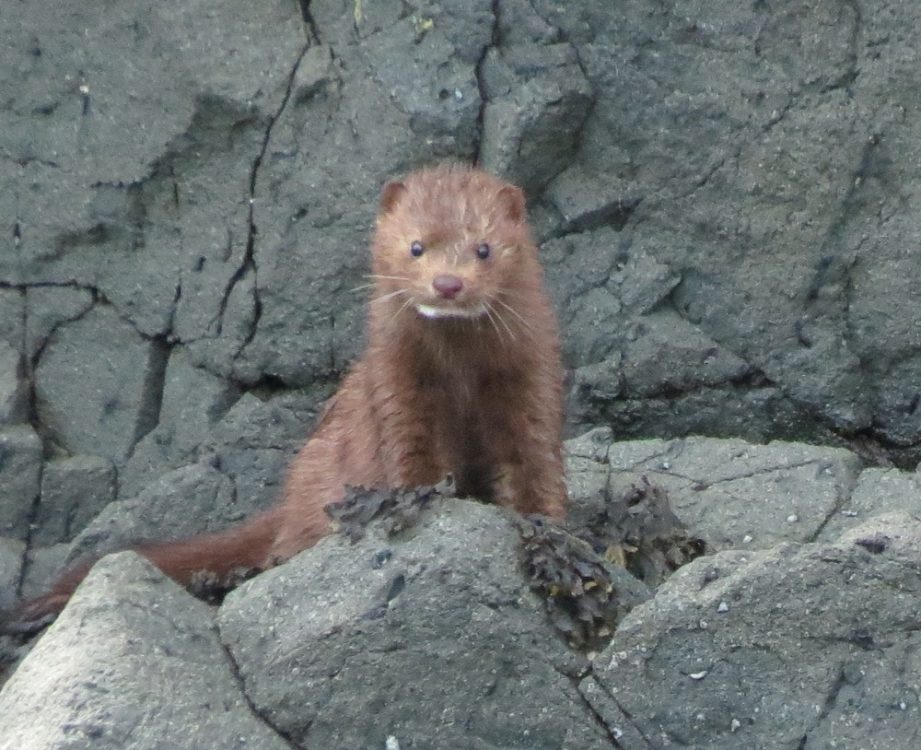Conuma River is located on the road to Tahsis and is quite the river. The Conuma Gorge that is found just off the road is incredible. If you turn right just past the Conuma River bridge and drive up maybe a km, you can view this creek in all its glory, but be careful, if you slip into this gorge, you could disappear forever. I wonder if this creek has ever been kayaked before or even if it would be possible.
The road to Tahsis is full of wild water and incredible waterfalls. It’s one of those drives that just amazes one. It’s best to go in the spring during the time when these rivers and creeks are at their fullest. Bring your camera to capture these incredible views, and you never know what else you might see, there are bears, cougars, deer, elk, and many types of birds and wildflowers here to put on film.
Most of the creeks and rivers in this area are swarming with fish, rainbows, cutthroats, dollies, and the odd brown trout so bring your fishing pole too. Below the road, the river quickly calms down and has some great fishing areas available. There are some awesome rustic campsites along this section where you can fish, hike and photograph wildlife all at the same time. It’s a pretty awesome river.

The Conuma Fish Hatchery is located just up from the estuary and is a great place to learn about the various fish species that spawn here in the river. On the coast of BC, we have five salmon that return from the sea to lay their eggs in our rivers and lakes. These are the Chinook, Chum, Coho, Pink and Sockeye salmon species.
Every fall, many of us, myself included love to head down to our local island Rivers to watch the salmon run, and as a bonus, you have a great chance to see black bears and other animals feeding along the river banks. The best place to view Salmon during their spawning runs is at one of the many hatcheries that dot our coast and to me, the best one is the Conuma River Hatchery.

The Conuma River Hatchery is located at the head of the Tlupana Inlet on the west coast of Vancouver Island about four kilometres upstream of the Conuma River Estuary. It was originally designated as a chum enhancement facility in 1978, since then it has evolved into a major Chinook, Chum, and Coho enhancement facility.
The hatchery annually releases about 3.5 million sea pen-reared Chinook smolts into five different watersheds and estuaries in the Nootka Sound area. The hatchery also rears Chum and Coho in the Conuma River and Chum in the Tlupana, Canton, and Sucwoa Rivers. In addition to these watersheds, they also work to enhance both the Gold River and Burma River Chinook runs. They have helped the Tahsis volunteer salmon enhancement society in the past and believe that working with these small organizations is an important part of their operations and are quite happy to continue to help.
The best times to visit this facility are from September to October when adult capture and egg-take processes occur and from March to June when juveniles are reared and released. All visits must be arranged, you can contact them for a tour booking. School tours are a favourite with the kids.

I contacted Mike Austin at the hatchery, and he arranged a tour for my wife Gina and me. The operations manager spent almost the whole afternoon showing us around the hatchery. The hatchery has come a long way from its humble beginnings. It’s quite the place now. When we were there they had pens filled with giant chinook salmon from the Gold River and other pens with Burma River Chinook, these were big fish that had just been beached and seined from these rivers.
Once these fish are gathered, they will remove the eggs and milt from them, fertilize them and then place them on screens in a large building full of long shallow gravel layered channels, the screens sit on top of the gravel bottom and a flow of water runs over them. The eggs will hatch into alevins and drop down into the gravel. They are about 3 cm long after hatching, but they have no fins and cannot swim, they can push themselves for short distances through the water with their tails.
The young salmon stay there among the gravel to grow. They have an egg sac below their bellies that provide all their food. By about 6 weeks the alevins have used up their egg sacs, and have grown fins, although still small these fins will allow them to swim. At this time they are placed in outside pens.

The hatchery has done limited marking of fish up until this year. They plan on mass-marking 2.7 million salmon this year, I viewed the facility that has been enhanced for this operation. There was a UV water treatment system being installed during our tour, this will keep the water in prime condition during the marking. Tables with trays are set up for the fry to sit while being marked, marking involves removing the adipose fin off of the hatchery fish.
Prior to mass marking, restrictions imposed threatened to close or greatly curtail historic salmon fisheries throughout the region. In addition to the recreational and cultural values involved, the potential loss of fishing opportunities presented a severe economic threat to fishing families and entire communities, especially in rural areas of Vancouver Island. Once mass marking is established, fishery managers will be able to mitigate that situation by creating a growing number of “mark-selective fisheries,” which require fishers to release any unmarked wild salmon they encounter. These rules protect wild salmon while permitting fishers to retain hatchery fish produced for harvest.

Predication in the pens has been pretty bad in past years and some years they could lose up to 30% of their fish, mostly to black bears but mink and eagles would play a role in fry losses. They have now closed the whole hatchery in high wire fencing and closed the pens in not only wire fencing but have electrified some of them. Predication has been mostly curtailed now.
After the eggs and milt have been removed from the adult fish, the remains are trucked just downriver and left for the predators, the bears will move these fish all along the river shores as they feed, and some wind up in the water where the nutrients are added to the water, we walked along the river shore and along the newly added side channel that has just been built, and you could see the value of this in the lush growth there in the shore plants and trees.
The side channel was constructed in 2008-2009 to compensate for the loss of salmon production in the mainstream Conuma River due to logging impacts. It was designed for Coho and Chum salmon spawning and to produce up to 21,000 Coho smolts and 2.7 million chum fry annually. Adult Chinook salmon also use the channel to access the raceways at Conuma Hatchery.

You can access this side channel by trails located just past the hatchery gate, this is a great place to view wildlife like bears and mink, and it’s a great place for bird watching. There is a big sign here that details the history of the hatchery. Please be bear aware here as there are lots of bears this time of year.
The estuary is big and full of wildlife, bring your camera and take a hike here, you won’t forget it.